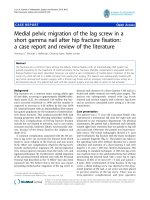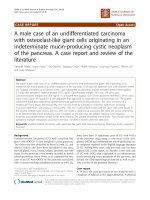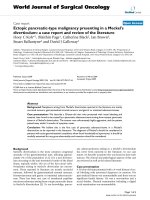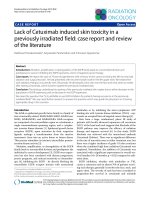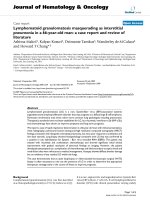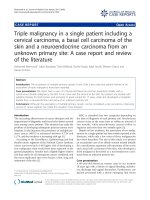Positional treatment without mechanical ventilation in a very preterm infant with unilateral pulmonary interstitial emphysema: Case report and review of the literature
Bạn đang xem bản rút gọn của tài liệu. Xem và tải ngay bản đầy đủ của tài liệu tại đây (2.5 MB, 5 trang )
Lei et al. BMC Pediatrics
(2019) 19:267
/>
CASE REPORT
Open Access
Positional treatment without mechanical
ventilation in a very preterm infant with
unilateral pulmonary interstitial emphysema:
case report and review of the literature
Xiaoping Lei1, Oliver Stangl2, Christina Bösche2, Kristina Stuchlik2, Roland Czorba3 and Christian Wieg2*
Abstract
Background: Pulmonary interstitial emphysema (PIE) in very low birth weight infants is a rare but severe complication.
Although most of these air leaks develop in mechanically ventilated infants, they have also been reported in infants
exposed only to nasal continuous positive airway pressure (CPAP). The optimal treatment for PIE is still under
discussion and includes different approaches such as unilateral intubation, high frequency oscillation ventilation
and even surgical lobectomy. However, as yet, there has been no report on complete resolution of unilateral PIE
by positioning therapy without mechanical ventilation.
Case presentation: We report the case of a 28+1gestational week twin, 990 g birth weight, Apgar 9–10-10. After
stabilization with nasal CPAP the baby received surfactant by less invasive surfactant application (LISA) technique
in the delivery room after 35 min of life, and continued respiratory support with nasal CPAP. At day 5 X-ray presented
unilateral PIE, while pCO2 increased from 40 mmHg to 55 mmHg and FiO2 from 0.21 to 0.28 to achieve SpO2 in the
target range of 89–94%. The baby was treated by strict positioning on the affected hemithorax in a special splint while
spontaneously breathing on High Flow Nasal Cannula (HFNC). Complete resolution of the unilateral PIE was observed
after 96 h. No chronic lung disease developed.
Conclusion: For unilateral PIE in very preterm infants, positioning on the affected hemithorax without mechanical
ventilation is a therapeutic option.
Keywords: Pulmonary interstitial emphysema, Non-invasive treatment, Prematurity
Background
Pulmonary interstitial emphysema (PIE) is a well known
and severe complication in very premature newborns with
respiratory distress syndrome (RDS) receiving invasive
mechanical ventilation. However, few PIE cases - unilateral or bilateral - have been reported in premature babies
exposed to nasal continuous positive airway pressure
(nCPAP) [1–7]. So far, there is no standard treatment for
unilateral PIE, and several treatment approaches have
been reported in literature, including selective unilateral
intubation and ventilation [8–12], High Frequency
* Correspondence:
2
Department of Neonatology and Pediatric Intensive Care, Klinikum
Aschaffenburg, Am Hasenkopf 1, Aschaffenburg, 63739 Aschaffenburg,
Bavaria, Germany
Full list of author information is available at the end of the article
Oscillation Ventilation (HFOV) and High Frequency Jet
Ventilation (HJFV) [12–16], Neurally Adjusted Ventilatory Assist (NAVA) [17, 18], and even surgical lobectomy
[19–21]. Positioning of the baby on the affected side is
considered an adjunct to these therapies [12, 15, 22, 23].
However, as yet, there is no report on complete resolution
of unilateral PIE by positioning therapy without mechanical ventilation.
We report on a very low birth weight (VLBW) infant
who developed unilateral PIE secondary to nasal CPAP.
The baby was treated by a strict positioning on the affected hemithorax in a special splint while spontaneously
breathing on high-flow nasal cannula (HFNC). PIE completely resolved in 96 h. Considering the reported
© The Author(s). 2019 Open Access This article is distributed under the terms of the Creative Commons Attribution 4.0
International License ( which permits unrestricted use, distribution, and
reproduction in any medium, provided you give appropriate credit to the original author(s) and the source, provide a link to
the Creative Commons license, and indicate if changes were made. The Creative Commons Public Domain Dedication waiver
( applies to the data made available in this article, unless otherwise stated.
Lei et al. BMC Pediatrics
(2019) 19:267
Page 2 of 5
interventions in literature, our aim is to add to the available knowledge on therapy concepts for unilateral PIE.
Case presentation
Second twin, born after 28+ 1 weeks of gestation, 990 gbirth weight, Apgar 9–10-10. Steroid prophylaxis was
given to the mother 96 h before C-Section was performed due to onset of labour and premature rupture of
the membranes. No clinical symptoms, laboratory, or
histological signs of chorioamnionitis were detected.
After stabilization with nasal CPAP (FiO2 0.4, Silverman
score 4) the baby received surfactant by less invasive surfactant application (LISA) procedure in the delivery
room 35 min of after birth. Initial X-ray (one hour after
LISA) showed RDS 1° (Fig. 1). After good response to
surfactant, respiratory support with nasal CPAP (5.5 to
6.5 mbar) was continued for the following 5 days with
FiO2 0.21 for SpO2 89–94%. PCO2 ranged between 40
and 50 mmHg and the Silverman Score was 1–2. The
pressure levels of nasal CPAP were 6.5 mbar for the first
8 h after LISA, followed by 6.0 mbar for another 12 h
and 5.5 mbar from 2nd to 5th day. A second X-ray at
the age of 24 h showed regression of RDS and bilateral
symmetrical ventilation of the lung, without signs of
over-distension or air leak. Thus, unilateral surfactant
delivery could be ruled out.
At day 5, pCO2 increased from 40 to 55 mmHg and
FiO2 from 0.21 to 0.28 for SpO2 89–94% was needed,
while apnea–bradycardia syndrome was more pronounced
(minimal heart rate 75/min). The Silverman Score rose to
3–4. A sepsis was ruled out by negative Il-6 and CRP, and
blood pressure measurements were normal. X-ray indicated severe left unilateral PIE, shifting the mediastinum
to the right (Fig. 2). We changed nasal CPAP to HighFlow Nasal Cannula (HFNC) with flow 6 l/min, used a 1
Fig. 1 Initial X-ray chest: respiratory distress syndrome grade 1°. One
hour after LISA. Nasal CPAP settings: 6.5 mbar, FiO2 0.21
Fig. 2 X ray chest day 5 of life: Severe left unilateral pulmonary
interstitial emphysema. Left-sided diffuse pulmonary interstitial
emphysema, mild mediastinal shift to the right. Nasal nCPAP settings:
5.5 mbar, FiO2 0.28
mm bi-nostril prong-interface and a small pacifier to keep
the mouth close, by calculated pressure 3.0–4.0 mbar and
performed a strict positioning therapy in a splint (Fig. 3a
and b) on the affected left hemithorax. This stiff, but pliant padded plastic splint is normally used for the
stabilization of forearm bone-fractures in the Emergency
Room. Mild hypercapnia (paCO2 60 mmHg) occurred and
FiO2 was needed up to 0.4 to reach target SpO2 of
88–92%. Following unilateral positioning in the splint, the
respiratory status improved, FiO2 was gradually decreased
from 0.4 to 0.25, and complete resolution of PIE was demonstrated by X-ray after 96 h (Fig. 4). We continued
HFNC with FiO2 between 0.21 and 0.25 up to day 35 (33+
2
gestational week). When the baby was discharged after
10 weeks, SpO2 was 99% (Table 1). Though a few bilateral
central opaque zones were visible, significant signs of
bronchopulmonary dysplasia (BPD) were not detectable
on X-ray (Fig. 5). Several ultrasound examinations of the
brain were performed including one at discharge. We
never detected any signs of Intraventricular Haemorrhage
(IVH) or any stages of periventricular Leukomalacia
(PVL).
Discussion and conclusions
This case demonstrates that unilateral PIE developed in
a spontaneously breathing baby, may resolve by positioning the baby on the affected hemithorax in a special
splint without mechanical ventilation.
Lei et al. BMC Pediatrics
(2019) 19:267
Fig. 3 a The splint used for Positioning Therapy. b Positioning
Therapy in the splint
Fig. 4 X ray chest day 9 Resolved Unilateral Pulmonary Interstitial
Emphysema. No cysts are presented in the left lung, mediastinal shift
recovered. High-flow nasal cannula settings: Flow 6 L/min, FiO2 0.21–0.25
Page 3 of 5
PIE is a life-threatening form of air leak syndrome in very
premature infants with RDS. It also occurs in MeconiumAspiration-Syndrome in term-infants. Its pathophysiology
was firstly discussed by Macklin [24] in 1939. When infants
are exposed to positive pressure ventilation, especially but not exclusively - while intubated and mechanically
ventilated, potential loss of the epithelial integrity of the
small airways, sacculi or immature alveoli permits entering
air into the perivascular tissue of the pulmonary interstitium. By spreading into the bronchovascular bundles, it
may result in pneumothorax, pneumomediastinum, pneumopericardium, pneumoperitoneum, subcutaneous emphysema, and terminally massive air embolism [24, 25].
The entrapment of air can initiate compression of functional lung tissue and vascular structures, resulting in adjacent atelectasis, leading to severe impairment of lung
function and increased respiratory distress of the baby.
Prematurity, meconium aspiration resuscitation, and
hyperoxia are known to be risk factors for PIE [26–28].
A high risk for air leaks including PIE seems to be surfactant deficiency in mechanical ventilated very premature babies not treated with surfactant [27, 29]. A study
from the pre-surfactant era, the incidence of PIE in ventilated preterm infants is reported up to 32% [27]. Technical risk factors include use of high peak inspiratory
pressure (PIP) and/or high positive end expiratory pressure (PEEP) in mechanical ventilation, high (FiO2), long
inspiratory time and large tidal volumes [1, 25–27, 30].
Malpositioning of the tube in one bronchus may also be
responsible for unilateral PIE [30].
In our case, the baby received LISA followed by nasal
CPAP, exposed to widely accepted pressure levels in the
delivery room, avoiding mask or mechanical ventilation.
This case is consistent with a previous study that indicates
the incidence of PIE reaches 11.5% in cases receiving nasal
CPAP only and/or non-invasive ventilation in delivery
room management [1]. The X-ray on the first day (Fig. 1)
shows symmetrical lung ventilation ruling out the main
differential diagnoses unilateral surfactant delivery, adenocystic lung malformation and congenital lobe emphysema.
When PIE is treated successfully, secondary serious
complications can be prevented. In older reports, fatality
rates of premature infants with PIE reach 80% [31] and recent data still show a high risk of death (37%) [28]. In survivors, high proportions of adverse outcomes with
significant morbidity such as IVH (54%) and BPD (77%)
are reported [1, 32].
The generally accepted treatment strategy for PIE includes maintaining low levels of peak inspiratory pressure,
mean airway pressure and low tidal volumes, accepting
high FiO2 and moderate hypercapnia. Regarding our case,
unilateral PIE resolved completely by positional treatment
and reduction of the calculated airway pressure. Previous
studies from the 1980’s [22, 23] reported that positioning
Lei et al. BMC Pediatrics
(2019) 19:267
Page 4 of 5
Table 1 The Clinical Parameters of this Case: From Birth to Discharge
Ventilation
Before LISA
(0-35 min)
The first day
after LISA
2nd-5th day
Onset PIE
(5th day)
Begin positioning
therapy
5th–9th day
10th - 35th day
To discharge
n CPAP
n CPAP
n CPAP
n CPAP
HFNC
HFNC
HFNC
No
Target SpO2%
89–94
89–94
89–94
89–94
89–92
89–92
90–95
92–99
FiO2%
0.4
0.21
0.21
0.28
0.4
From 0.4 to 0.25
From 0.25 to 0.21
air
Silverman Score
3
1–2
0–1
3–4
1–3
1–2
0–1
0–1
pCO2 mmHg
35
40
40–50
53
60
40–55
45–55
40–55
Pressure mbar
6.5
6.5–6.0
5.5
5.5
3–4 (calc)
3–4(calc)
2–3(calc)
None
CPAP continuous positive airway pressure, HFNC High Flow Nasal Cannula, LISA less invasive surfactant application, PIE pulmonary interstitial emphysema
the baby laterally on the affected hemithorax for several
hours, while ventilating with low airway pressure achieved
ideal results in neonates with unilateral PIE.
In 1988, Gortner et al. [15] reported on a concept of
positioning therapy combined with HFOV which proved
remarkable successful. By positioning the baby on the affected side, the mediastinum, following gravity, can compress the lung of the underlying hemithorax, while the
unaffected lung is still ventilated. To keep the baby in
the right position we used a splint as described above.
The soft, padded surface protects the vulnerable skin of
the baby. Fixing spontaneously breathing premature infants without sedation in a lateral position may be challenging, so the splint provides an effective significant
support. We here demonstrate that positioning therapy
can be successful for babies receiving HFNC also.
Using a three-dimensionally printed airway model a
recent study [33] demonstrated that, while the baby’s
mouth closed, a flow of 6 l/min in HFNC can achieve
pressures of approximately 4.0 mbar in preterm infants.
HFNC also provides active CO2 out-washing from the
nasopharynx [33]. In view of these potential advantages
we selected this mode during positioning therapy. It
Fig. 5 X ray chest 10 weeks of life: No significant signs of
bronchopulmonary dysplasia 10 weeks after birth. Bilateral central
opaque zones are visible, the baby didn’t need oxygen or any
respiratory support for SpO2 > 92%
should be emphasized, that there are no data available
comparing HFNC versus nCPAP in unilateral PIE. Thus,
the mode of gas delivery may not have been as important as the positioning therapy in our case.
The challenge in the treatment of unilateral PIE is to
find the balance between beneficial therapeutic approaches for the affected lung and the potential harmful
side effects for the contralateral lung. Selective ventilation
of the non-affected lung has been advocated as it provides
the possibility of reabsorption of interstitial air by reducing the alveolar pressure of the affected lung to zero.
Atelectasis and ventilator-induced lung injury of the ventilated lung were reported as the limitations of selective
ventilation [8]. High frequency ventilation has also been
used for PIE to attain an adequate gas exchange with
lower mean airway pressures and volume than conventional ventilation [13]. However, HFOV itself contributes
to PIE [25] and the low volume strategy induce alveolar
hypoventilation of the unaffected lung, leading to severe
hypercapnia and dependency on high FiO2.
In our case, strictly performed positioning on the affected hemithorax, combined with HFNC, seems to be a
successful alternative to more invasive strategies in the
treatment of unilateral PIE. The use of a flexible splint
provides the possibility to maintain the baby in the required position. This approach may offer a good chance
to reduce invasive ventilation, and if tolerated, it should
be considered to be the first line treatment. However, it
must be emphasised that infants who continue to have
respiratory acidosis and/or significant work of breathing
will require other types of respiratory support.
Abbreviations
BPD: Bronchopulmonary dysplasia; CPAP: Continuous positive airway
pressure; HFJV: High Frequency Jet Ventilation; HFNC: High Flow Nasal
Cannula; HFOV: High Frequency Oscillation Ventilation; IVH: Intraventricular
haemorrhage; LISA: Less invasive surfactant application; NAVA: Neurally
Adjusted Assist Ventilation; PEEP: Positive end-expiratory pressure;
PIE: Pulmonary interstitial emphysema; PIP: Peak inspiratory pressure;
PVL: Periventricular leucomalacia; RDS: Respiratory distress syndrome
Acknowledgements
Professor Christoph Haertel and Professor Giles Vince for reviewing the Manuscript.
Lei et al. BMC Pediatrics
(2019) 19:267
Authors’ contributions
XL wrote the first draft of the manuscript and was the leading author. OS
designed the device for position treatment. KS, CB and RC reviewed the
literatures and critically revised the manuscript. CW was in charge of the
treatment and was the senior author. All authors approved the final version.
Funding
The present report did not receive any forms of funding.
Availability of data and materials
All the important information of this case are included in the manuscript.
Ethics approval and consent to participate
This case report using de-identified medical records is approved by Ethical
Committee of the Bavarian Board of Physicians .
Consent for publication
A informed consent was written by the parents for publication of this manuscript.
Competing interests
The authors declare that they have no competing interests.
Author details
1
Department of Neonatology, Affiliated Hospital of Southwest Medical
University, Luzhou, Sichuan, China. 2Department of Neonatology and
Pediatric Intensive Care, Klinikum Aschaffenburg, Am Hasenkopf 1,
Aschaffenburg, 63739 Aschaffenburg, Bavaria, Germany. 3Department of
Gynecology and Obstetrics, Klinikum Aschaffenburg, Aschaffenburg,
Germany.
Received: 5 December 2018 Accepted: 18 July 2019
References
1. Hummler HD, Parys E, Mayer B, Essers J, Fuchs H, Schmid M. Risk indicators
for air leaks in preterm infants exposed to restrictive use of endotracheal
intubation. Neonatology. 2015;108:1–7.
2. Morley CJ, Davis PG, Doyle LW, Brion LP, Hascoet JM, Carlin JB, et al. Nasal
CPAP or intubation at birth for very preterm infants. N Engl J Med. 2008;
358:700–8.
3. Gürakan B, Tarcan A, Arda IS, Coşkun M. Persistent pulmonary interstitial
emphysema in an unventilated neonate. Pediatr Pulmonol. 2002;34:409–11.
4. Crosswell HE, Stewart DL. Special feature: radiological case of the month.
Pulmonary interstitial emphysema in a nonventilated preterm infant. Arch
Pediatr Adolesc Med. 2001;155:615–6.
5. Dembinski J, Heep A, Kau N, Knopfle G, Bartmann P. CT imaging of
pulmonary lobar interstitial emphysema in a spontaneous breathing
preterm infant. Am J Perinatol. 2002;19:285–90.
6. Gessler P, Toenz M, Gugger M, Pfenninger J. Lobar pulmonary interstitial
emphysema in a premature infant on continuous positive airway pressure
using nasal prongs. Eur J Pediatr. 2001;160:263–4.
7. Bawa P, Soontarapornchai K, Perenyi A, Goldfisher R, Amodio J. Development
of localized pulmonary interstitial emphysema in a late preterm infant without
mechanical ventilation. Case Rep Pediatr. 2014;2014:429797.
8. Oliver JE, Smith IJ. Treatment of severe localized pulmonary interstitial
emphysema by selective bronchial intubation. Postgrad Med J. 1984;60:58–9.
9. Chalak LF, Kaiser JR, Arrington RW. Resolution of pulmonary interstitial
emphysema following selective left main stem intubation in a premature
newborn: an old procedure revisited. Paediatr Anaesth. 2007;17:183–6.
10. O’Donovan D, Wearden M, Adams J. Unilateral pulmonary interstitial
emphysema following pneumonia in a preterm infant successfully treated
with prolonged selective bronchial intubation. Am J Perinatol. 1999;16:327–31.
11. Joseph LJ, Bromiker R, Toker O, Schimmel MS, Goldberg S, Picard E.
Unilateral lung intubation for pulmonary air leak syndrome in neonates: a
case series and a review of the literature. Am J Perinatol. 2011;28:151–6.
12. Filho LV, Rossi FD, Deutsch AD, Yagui AC, Timenetsky K, Rebello CD.
Persistence of ventilatory defect after resolution of pulmonary interstitial
emphysema in a preterm baby. J Matern-Fetal Neo M. 2010;23:712–6.
13. Cools F, Henderson-Smart DJ, Offringa M, Askie LM. Elective high frequency
oscillatory ventilation versus conventional ventilation for acute pulmonary
dysfunction in preterm infants. Cochrane Database Syst Rev. 2009;8:CD000104.
Page 5 of 5
14. Squires KA, De Paoli AG, Williams C, Dargaville PA. High-frequency
oscillatory ventilation with low oscillatory frequency in pulmonary interstitial
emphysema. Neonatology. 2013;104:243–9.
15. Gortner L, Pohlandt F, Bartmann P. Treatment of unilateral space-occupying
pulmonary interstitial emphysema with positioning measures and highfrequency ventilation. Monatsschr Kinderheilkd. 1988;136:432–5.
16. Keszler M, Donn SM, Bucciarelli RL, Alverson DC, Hart M, Lunyong V, et al.
Multicenter controlled trial comparing high-frequency jet ventilation and
conventional mechanical ventilation in newborn infants with pulmonary
interstitial emphysema. J Pediatr. 1991;119:85–93.
17. Lee SR. Application of selective bronchial intubation versus Neurally
adjusted Ventilatory assist in the Management of Unilateral Pulmonary
Interstitial Emphysema: an illustrative case and the literature review. Ajp
Rep. 2017;7:e101–5.
18. Lee SR, Shek CC. Resolution of localized pulmonary interstitial emphysema
in two neonates - why does neurally adjusted ventilatory assist work? J Clin
Neonatol. 2015;4:115–8.
19. Matta R, Matta J, Hage P, Nassif Y, Mansour N, Diab N. Diffuse persistent
interstitial pulmonary emphysema treated by lobectomy. Ann Thorac Surg.
2011;92:73–5.
20. Castillo BTD, Gordillo I, García ER, Lafever SN, Cortés RG, Villaescusa JU, et al.
Diffuse persistent pulmonary interstitial emphysema secondary to
mechanical ventilation in bronchiolitis. BMC Pulm Med. 2016;16:139.
21. Messineo A, Fusaro F, Mognato G, Sabatti M, D'Amore ES, Guglielmi M. Lung
volume reduction surgery in lieu of pneumonectomy in an infant with severe
unilateral pulmonary interstitial emphysema. Pediatr Pulmonol. 2001;31:389–93.
22. Cohen RS, Smith DW, Stevenson DK, Moskowitz PS, Graham CB. Lateral
decubitus position as therapy for persistent focal pulmonary interstitial
emphysema in neonates: a preliminary report. J Pediatr. 1984;104:441.
23. Schwartz AN, Graham CB. Neonatal tension pulmonary interstitial
emphysema in bronchopulmonary dysplasia: treatment with lateral
decubitus positioning. Radiology. 1986;161:351–4.
24. Macklin CC. Transport of air along sheaths of pulmonic blood vessels from
alveoli to mediastinum: clinical implications. Arch Intern Med. 1939;64:913–26.
25. Gummalla P, Mundakel G, Agaronov M, Lee H. Pneumoperitoneum without
Intestinal Perforation in a Neonate: Case Report and Literature Review. Case
Reports in Pediatr. 2017;2017:6907329.
26. Nunez-Ramiro A, Aguar M, Cernada M, Parra-Llorca A, Vento M. Oxygen
needs during resuscitation and surfactant to achieve stabilisation were
independent risks factors for pulmonary interstitial emphysema in preterm
infants. Acta Paediatr. 2018;107(1):28.
27. Hart SM, McNair M, Gamsu HR, Price JF. Pulmonary interstitial emphysema
in very low birthweight infants. Arch Dis Child. 1983;58(8):612–5.
28. Verma RP, Chandra S, Niwas R, Komaroff E. Risk factors and clinical
outcomes of pulmonary interstitial emphysema in extremely low birth
weight infants. J Perinatol. 2006 Mar.;26(3):197–200.
29. BahadueFL SR. Early versus delayed selective surfactant treatment for
neonatal respiratory distress syndrome. Cochrane Database Syst Rev. 2012;
11:CD 001456.
30. Greenough A, Dixon AK, Roberton NR. Pulmonary interstitial emphysema.
Arch Dis Child. 1984;59(11):1046–51.
31. Gaylord MS, Thieme RE, Woodall DL, Quissell BJ. Predicting mortality in lowbirth-weight infants with pulmonary interstitial emphysema. Pediatrics. 1985
Aug.;76(2):219–24.
32. Laughon M, O'Shea MT, Allred EN, Bose C, Kuban K, Van Marter LJ, et al.
Chronic lung disease and developmental delay at 2 years of age in children
born before 28 weeks' gestation. Pediatrics. 2009;124(2):637–48.
33. Nielsen KR, Ellington LE, Gray AJ, Stanberry LI, Smith LS, DiBlasi RM. Effect of
high-flow nasal cannula on expiratory pressure and ventilation in infant,
pediatric, and adult models. Respir Care. 2018;63(2):147–57.
Publisher’s Note
Springer Nature remains neutral with regard to jurisdictional claims in
published maps and institutional affiliations.
